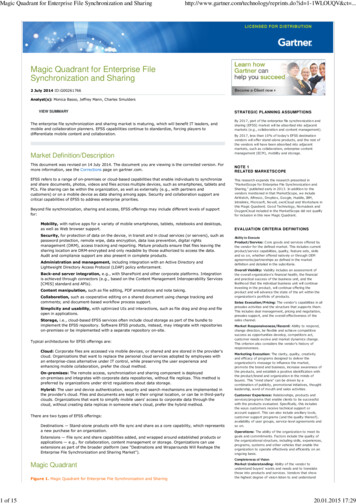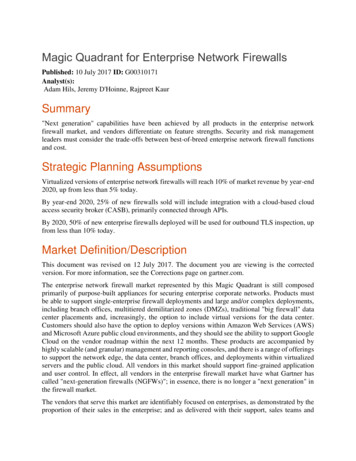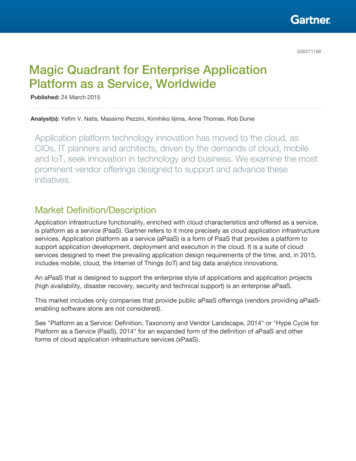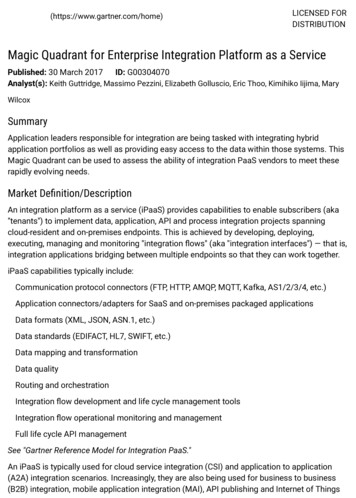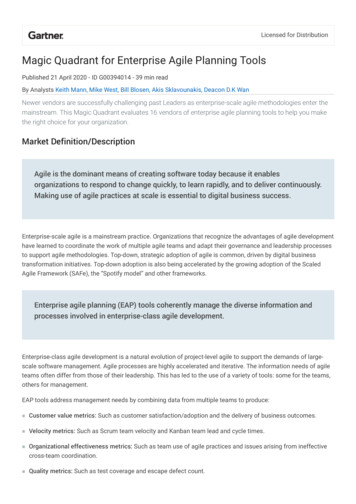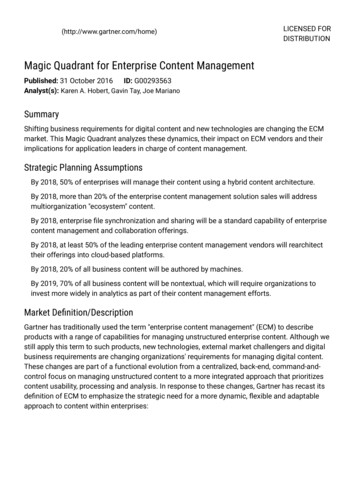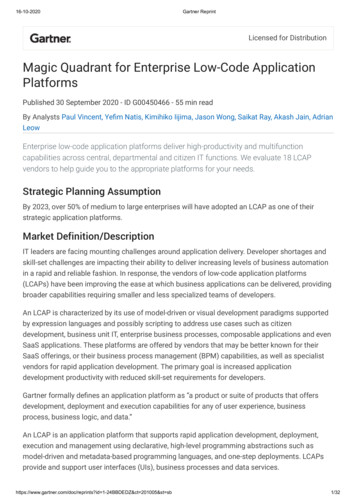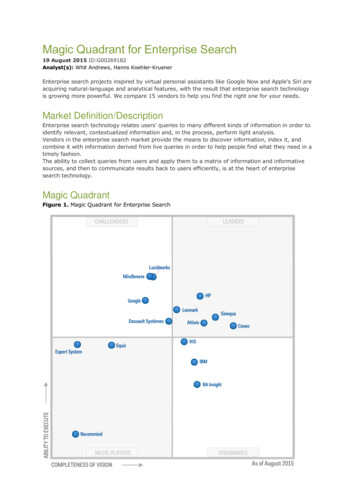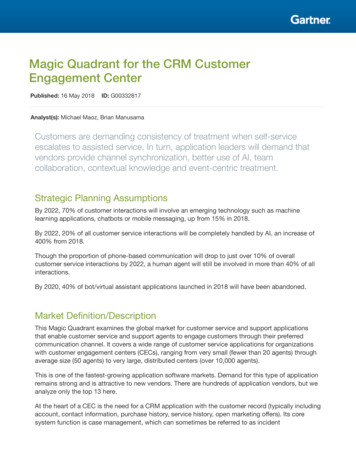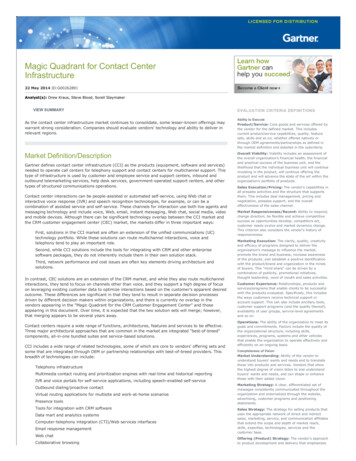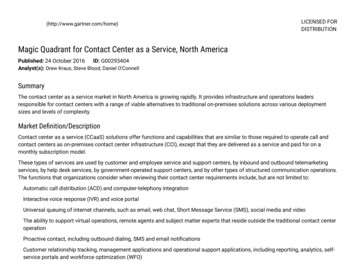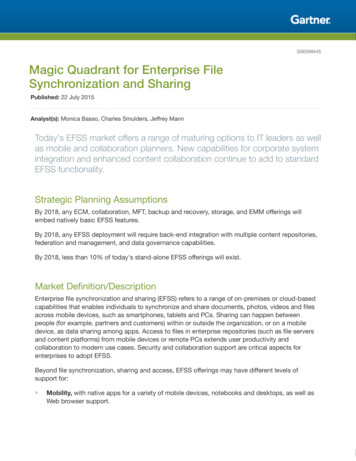
Transcription
G00268445Magic Quadrant for Enterprise FileSynchronization and SharingPublished: 22 July 2015Analyst(s): Monica Basso, Charles Smulders, Jeffrey MannToday's EFSS market offers a range of maturing options to IT leaders as wellas mobile and collaboration planners. New capabilities for corporate systemintegration and enhanced content collaboration continue to add to standardEFSS functionality.Strategic Planning AssumptionsBy 2018, any ECM, collaboration, MFT, backup and recovery, storage, and EMM offerings willembed natively basic EFSS features.By 2018, any EFSS deployment will require back-end integration with multiple content repositories,federation and management, and data governance capabilities.By 2018, less than 10% of today's stand-alone EFSS offerings will exist.Market Definition/DescriptionEnterprise file synchronization and sharing (EFSS) refers to a range of on-premises or cloud-basedcapabilities that enables individuals to synchronize and share documents, photos, videos and filesacross mobile devices, such as smartphones, tablets and PCs. Sharing can happen betweenpeople (for example, partners and customers) within or outside the organization, or on a mobiledevice, as data sharing among apps. Access to files in enterprise repositories (such as file serversand content platforms) from mobile devices or remote PCs extends user productivity andcollaboration to modern use cases. Security and collaboration support are critical aspects forenterprises to adopt EFSS.Beyond file synchronization, sharing and access, EFSS offerings may have different levels ofsupport for: Mobility, with native apps for a variety of mobile devices, notebooks and desktops, as well asWeb browser support.
Security for data protection on devices, in transit and in cloud services (or servers). It includespassword protection, remote wipe, data encryption, data loss prevention (DLP), digital rightsmanagement (DRM), document protection, encryption key management and access tracking. Administration and management, including integration with an Active Directory andLightweight Directory Access Protocol (LDAP) policy enforcement. Back-end server integration through connectors to main corporate servers (for example,SharePoint) and cloud services; also, support for Content Management Interoperability Services(CMIS) and APIs. Content manipulation, such as file editing, file annotations and note taking. Collaboration, such as cooperative editing on a shared document using change tracking andcomments; and document-based workflow process support with basic (but incomplete)compatibility with Microsoft Office. Simplicity and usability with optimized user interfaces (UIs) and interactions, such as file dragand-drop and file open in applications. Storage for the central data repository of the EFSS systems or services. It is an optionalcomponent and can be cloud-based, on-premises or hybrid. Cloud EFSS services are bundledwith cloud storage. Software EFSS products may or may not have one main repository. Someproducts integrate with existing third-party repositories that are deployed on-premises or in thecloud.Typical architectures for EFSS offerings are: Public cloud: Corporate files are uploaded and stored in the provider's cloud storage foraccess and sharing. This architecture is preferred by organizations that need agility to supportexternal use cases and modern productivity for employees, without restrictions on the actualgeographical location of files. Hybrid: The user and device authentication, security and search mechanisms are implementedin the provider's cloud. Files and documents are in the original location, on-premises or in thirdparty clouds; a central EFSS repository may be present. A mix of repositories can be adopted.This architecture is preferred by organizations that want to enable smooth access to corporatedata from mobile devices, without creating data replicas in someone else's cloud. Private cloud: The EFSS platform is entirely deployed within a private data center. Thisarchitecture is preferred by organizations that want to control data location and have dataprivacy constraints. On-premises: The remote access, synchronization and sharing component is deployed onpremises and integrates with corporate data repositories, without file replicas. This method ispreferred by organizations that are under strict regulations about data storage.There are two substantially different types of EFSS offerings in the market (see "Destinations andWraparounds Will Reshape the Enterprise File Synchronization and Sharing Market"):Page 2 of 38Gartner, Inc. G00268445
Destinations: These are stand-alone products with file sync and share as a core capability, andthey represent a new purchase for an organization. Extensions: These are file sync and share capabilities added and wrapped around establishedproducts or applications, such as those for collaboration, content management or storage.Organizations can use extensions as part of the broader platform.The market for EFSS offerings has grown rapidly since 2010, with more than 140 players originatingfrom a variety of markets and technology backgrounds having different approaches and businessmodels. Destination vendors focus on EFSS, adding complementary content collaboration featuresfor users and back-end integrations with IT systems. Extension vendors belong to adjacentmarkets, such as collaboration, enterprise content management (ECM), managed file transfer (MFT),storage, backup, virtual workspaces and enterprise mobility management (EMM).Both types of EFSS offerings are subject to buyer consideration in EFSS evaluations. However, therelevance of EFSS extensions is limited to use cases or user categories that rely heavily on the"extended" IT product (for example, companies looking for mobile access to their ECM platformsfor a selected workforce). Organizations with more complex requirements — in terms of multiple usecases, integrating many data repositories, data governance, collaboration and business processes— tend to consider EFSS destination offerings. In this second case, decisions tend to be morecomplex, as most often they imply investments on new products or services, from a new supplier.Companies may end up using a combination of EFSS extensions and destinations (see "How toBuild EFSS Plans to Address Current and Future Business Requirements"). This Magic Quadrantfocuses only on EFSS destination offerings.Gartner, Inc. G00268445Page 3 of 38
Magic QuadrantFigure 1. Magic Quadrant for Enterprise File Synchronization and SharingSource: Gartner (July 2015)Vendor Strengths and CautionsAccellionAccellion is a private company based in Palo Alto, California. Founded in 1999, it operatesinternationally, with offices in London, Singapore and Ukraine. The company originally served thePage 4 of 38Gartner, Inc. G00268445
traditional file sharing and MFT market. Since 2010, it has refocused on mobile file synchronization,sharing and collaboration. Accellion has a track record with midsize to large regulated or securityconscious organizations, particularly in the government, technology and professional servicessectors. It is recognized for its flexible approach in addressing customers' requirements in theirproduct roadmaps, as indicated by reference customers. Its EFSS product, kiteworks, offers broadsupport for back-end integration, security and management. The user experience is optimized formobile users, being the first design point. The architecture employs a multitier model that separatesthe Web, application and data layers. The product kiteworks can be deployed on-premises, as aprivate cloud on-premises (virtual appliance on-premises), as a hosted cloud (via Amazon WebServices [AWS]) or hybrid cloud (mixing on-premises and hosted), or as a public cloud. The hybridmodel can combine the on-premises component with public and private cloud services.Accellion is a good fit for organizations that are prioritizing their EFSS initiatives for mobile access toback-end corporate data repositories, and that require customized mobile apps to supportdocument-centric business workflows, while ensuring data protection and compliance, particularlyin regulated markets.Strengths A proprietary mobile container is available to protect content through policies, without aseparate EMM product. Also, kiteworks integrates with Good Technology, Symantec andMobileIron for organizations that employ those EMM products or need enhanced policyenforcements. RESTful APIs and software development kits (SDKs) are available to build securemobile apps on the kiteworks content platform. Compliance and certifications are available for highly regulated markets, including FIPS PUB140-2, the Health Insurance Portability and Accountability Act (HIPAA), the U.S. FederalInformation Security Management Act (FISMA) and the Sarbanes-Oxley Act. Accellion supports the sharing of unlimited-size files (1 terabyte and beyond). This feature iscritical for engineering groups, graphics shops and video/audio production houses, which dealwith large media files, such as videos, source code or computer-aided design (CAD). Accellion offers broad support for back-end integration — for content access and copy — witha variety of systems and services, including Microsoft SharePoint, SharePoint Online, Windowsfile shares, EMC Documentum, OpenText, Microsoft OneDrive for Business, Dropbox, Box, andGoogle Drive for Work.Cautions Accellion's direct presence is limited outside the U.S., compared with some competitors.However, multiple distributors and resellers are present, including Dimension Data, Compuwareand Accuvant. Occasionally, references indicated issues with the implementation of Active Directory; it is notout of the box as promised, and may require support and development efforts.Gartner, Inc. G00268445Page 5 of 38
Collaborative editing capabilities are not yet available within the kiteworks mobile application,but they are being developed for future releases. Annotations are supported only for PDF files. Back-end integration with IBM products is not available. APIs to modify metadata for files arelimited (but available for folders). References indicate that the kiteworks interface is not veryintuitive, and that migrating to kiteworks from the old product is very difficult; however,improvements to the kiteworks interface were recently released.AcronisAcronis, founded in 2003, is a private company with U.S. headquarters in Burlington,Massachusetts, and operations in Europe, Asia/Pacific, North America and South America. Its corebusiness is enterprise backup and recovery software. Its mobility business unit originates from its2012 acquisition of GroupLogic. Its EFSS product, Acronis Access, supports file sharing and accessfrom mobile devices into specific enterprise content servers. It is normally deployed on-premises,but also can be in private and public cloud models. Acronis Access is delivered to the market in twoforms: Acronis Access Advanced for on-premises deployments and Acronis Files Cloud for clouddeployment by service providers. Acronis is expanding integration with enterprise servers and cloudservices, including Acronis' MassTransit MFT product, to support ad hoc file-sending workflows.Acronis is a viable option for organizations that invest in EFSS to raise mobile employees'productivity, and that want to keep data on-premises for security and control. In particular, AcronisAccess should be considered by organizations that already have deployed other Acronis' products,or that are interested in backup/recovery capabilities beyond EFSS.Strengths Acronis has strong mobile support, with a secure container and policy enforcement; it also hasa proprietary encrypted file system and database on top of the native device encryption. Itsupports audit logs for control and compliance, and is certified for HIPAA and FISMAcompliance. Acronis has back-end integration support through connectors for access and copy to onpremises SharePoint, file servers and network file shares, as well as cloud repositories. It alsohas support for REST and SOAP-based APIs to access and manage files. Acronis has a large base of global resellers and distributors to meet the needs of enterprisecustomers. Its customer feedback on support continues to be positive. Acronis is often found in regulated industries, such as financial services, legal, retail, energy andgovernment, and also in the education sector.Cautions Acronis' integration capabilities are limited. Connectors with most traditional enterprise systemsare missing, with the exception of Microsoft SharePoint, network drives and Salesforce.OpenID, WebDAV and CMIS support for broad back-end integration is not available.Page 6 of 38Gartner, Inc. G00268445
Content management capabilities are limited, missing support for metadata management,content analytics and native e-discovery. Acronis does not support BlackBerry. Enhanced security features are missing, such asgeofencing and Security Assertion Markup Language (SAML) support. No DRM capability is supported (yet) to protect shared documents once they are downloadedon an unmanaged device (for example, to revoke permissions to open, view and edit adocument).AirWatch by VMwareVMware's AirWatch was founded in 2003 and is headquartered in Atlanta. With a worldwidepresence and offices in all regions, AirWatch is a leading vendor in the EMM market. VMware, apublic company founded in 1998, with headquarters in Palo Alto, California, acquired AirWatch in2014. AirWatch's EFSS destination product, Content Locker, is a core element of VMware's visionon end-user computing. Content Locker is available on-premises or in cloud instances, and canintegrate with heterogeneous back-end data repositories (on-premises and cloud-based). ContentLocker can be deployed within AirWatch's Container, and often is part of AirWatch's EMMdeployments. VMware incorporated Content Locker in its VMware Workspace Suite, replacingHorizon Files, and plans further product integrations. Content Locker is also integrated withVMware's Socialcast. Content Locker's adoption is strongly driven by mobility priorities; however,the uptake for broader end-user computing scenarios, including PCs and virtual desktops, is stilllimited.AirWatch is viable for organizations that consider EFSS requirements to be part of enterprisemobility initiatives, and that are making EMM decisions — or, more broadly, end-user computinginitiatives — via VMware products. AirWatch also is viable for organizations that have AirWatch'sMobile Device Management in place and plan to add EFSS capabilities for employees on managedmobile devices.Strengths AirWatch's operations are mature, and its own cloud services (SaaS) run in the company's datacenters in Atlanta (in addition, they are implemented in different countries by local managementservice providers [MSPs]). AirWatch is a Leader in the EMM market. AirWatch's customer base is global. The company has a strong presence in markets outside theU.S. through local sales teams, channel partners and resellers. VMware's acquisition of thecompany is contributing to scale up AirWatch's capabilities in sales, operations and localsupport. Mobility support is extensive with geofencing, DRM with policies, and remote wipe throughintegration with AirWatch's EMM. Content Locker benefits from rich administration and usermanagement capabilities.Gartner, Inc. G00268445Page 7 of 38
Content Locker supports dynamic content watermark management. IT administrators can setrules for applying watermarks to specific documents before sharing or editing the content,based on users, groups or document types.Cautions Enhanced content management capabilities are not supported yet (for example, built-in supportfor e-discovery, archiving, integration with third-party search tools, user-defined metadata).Integration with third-party apps for content editing and co-authoring is limited. Although back-end integration is good, connectors to IBM Domino, Dropbox, Salesforce,Oracle and SAP are missing — as well as most APIs to support activities with folders, metadataand activity streams. References indicate that the vendor is still too focused on mobile enablement rather thanbroader EFSS use cases. They continue to report issues with Content Locker's maturity andperformances and with the UI's friendliness; they also report a lack of central administration forthe EFSS capability only. The integration of Content Locker with VMware Workspace Suite is available only for theEnterprise Edition license, and not in the Horizon 6 editions.BoxBox is a public company based in Los Altos, California. Founded in 2005, the company has aninternational presence, with offices in Europe and Asia, and it is among the most well-known of theEFSS players in the market today. The company completed its initial public offering (IPO) in January2015. Box provides secure cloud-based file sync, share and collaboration as "freemium" andpremium services. Box operates as public cloud in its data centers, which are based in the U.S. Boxis an EFSS destination offering that is available only in the public cloud. It focuses on balancing asimple user experience with the security and administrative needs of the organization. On top of thesecure cloud-based EFSS and storage core, Box has built a platform for enterprise content andcollaboration, business process, and workflow support. In June 2015, Box announced a strategicpartnership with IBM to implement the service on IBM cloud, and to integrate with IBM products,including mobile and content management products (but it is still too early to assess the real value).Box is a viable option for public cloud-friendly organizations that want to integrate file sync andshare services into re-engineered business processes; it also is a viable option for stand-alone usecases, particularly when they involve external-facing collaboration scenarios.Strengths It provides APIs for application integration and customization of the UI, and an improveddeveloper program. Microsoft Office 365's productivity apps have been integrated with Box.The vendor aims to become the data backbone in the cloud for business system applications. Box has numerous partners — including application developers and software, service, andhardware vendors — whose products are integrated with Box's offerings. Recent deals includePage 8 of 38Gartner, Inc. G00268445
AirWatch and Microsoft. Box has a strong channel program as well, with a large number ofpartners that resell and build Box solutions globally. Data protection is supported by recognizing and quarantining data containing sensitiveinformation, and by identifying aberrant downloading behavior. Box rolled out an optionalEnterprise Key Management (EKM) add-on feature that allows enterprise control of encryptionkeys in order to address data sovereignty and security concerns. Enhanced image sharing and 3D imaging technologies, originating from some recentacquisitions, are integrated with the Box platform. They address specific requirements in thehealthcare, media, architecture, engineering and construction sectors.Cautions Despite implementations in proprietary data centers, Box's offering is available only in a publiccloud model. There is no hybrid model that adds data storage on-premises. The movement orreplication of corporate content in Box's cloud repository is not a viable option for some ITorganizations. Native mobile support for content manipulation is limited — in particular, it is missing fullannotation capabilities across multiple file formats (it is PDF-only) and content editing; however,these can be added via third-party products, including Microsoft's. Synchronization options alsoare limited — they are missing "sync any folder," differential sync and LAN sync support. The freemium model may create problems when an organization decides to purchase Box as acorporate s
Magic Quadrant Figure 1. Magic Quadrant for Enterprise File Synchronization and Sharing Source: Gartner (July 2015) Vendor Strengths and Cautions Accellion Accellion is a private company based in Palo Alto, California. Founded in 1999, it operates internationally, with offices in London, Singapore and Ukraine. The company originally served the
